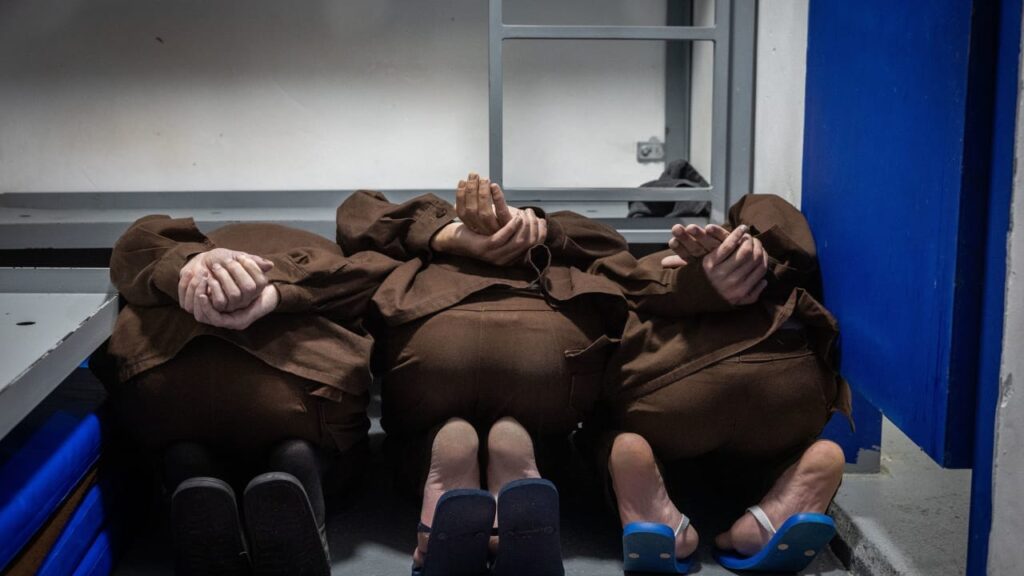
The question of what should happen to the terrorists who committed the October 7 massacre remains at large. Now, after the release of the final living hostages, it will finally begin to be answered.
The last living hostages are home. Many have already left the hospital. The images of their reunions with loved ones are still fresh in the nation’s mind. A sense of relief is still palpable.
But as the country begins to emerge from that particular trauma, a new question looms, one that few dared raise while Israelis were still in captivity for fear of how it might affect them: What should be done with the terrorists who carried out the October 7 massacre and now sit in Israeli jails?
Roughly 250 members of Hamas’s Nukhba unit, the terrorists who stormed the border, burned families alive, raped, pillaged, and dragged people into Gaza, are today in Israeli prisons under administrative detention.
Their trials have not begun. Their fate has not been decided. And now that no hostages remain in danger, that debate has begun in earnest.
Should they be tried in criminal courts according to standard legal procedures? Should they be tried in military courts? Or should they be tried under the 1950 Law on the Prevention and Punishment of Genocide, which mandates a death sentence for those committing acts intended to destroy a national, ethnic, racial, or religious group?
Some in the government are pushing for a special tribunal, one that would try the October 7 perpetrators not as individual murderers but as participants in a genocidal assault on the Jewish people.
Last week, Justice Minister Yariv Levin (Likud), Knesset Constitution Committee chair Simcha Rothman (Religious Zionist Party), and MK Yulia Malinovsky (Yisrael Beytenu) issued a joint statement pledging to promote the measure “at maximum speed,” aiming to bring captured Nukhba terrorists to trial. The fact that both coalition and opposition parties proposed this is significant.
According to the draft legislation, the special tribunal would operate outside the regular court system to avoid overburdening the courts and to ensure that these cases receive streamlined attention. The resolution also calls for the inclusion of international jurists as a way to lend the tribunal greater legitimacy.
Under the proposal, the trials would be public, with some of the usual evidentiary requirements eased to expedite proceedings. The bill reads: “It is hereby proposed to establish a special and separate legal mechanism appropriate for dealing with the crime of genocide. The mechanism is intended to enable rapid, efficient, and focused treatment while upholding the principles of justice and international law.”
Such trials, with defendants in Eichmann-style glass booths, would serve as powerful answers to the pernicious “genocide” libel being hurled at Israel. They would expose, for the world to see, those whose ideology truly seeks genocide, the annihilation of Jews, and who, through unspeakable brutality on October 7, tried to put into motion a dynamic that would bring it about.
Capital punishment for all 250 would obviously bring international outrage.
Another option, some suggest, would be to single out the most egregious perpetrators for the death penalty, while sentencing the rest to life in prison with no possibility of release.
The goal: to send an unmistakable signal to Hamas and other terror groups that those convicted of the October 7 massacre will never again walk free – just as Israel has refused to release Marwan Barghouti and other high-profile terrorists in past deals.
Death penalty both justice and deterrence
Advocates of capital punishment frame the death penalty here as both justice and deterrence. They argue that if there are no terrorists left to trade, the incentive to kidnap Israelis disappears.
Since the Oslo Accords, Israel has released more than 10,000 terrorists in swaps and “goodwill gestures.” The result has been painfully consistent – more kidnappings, more murders, more deals. On Friday, Makor Rishon ran photos of some 800 Israelis killed over the years by terrorists who were released in various prisoner exchanges since October 7.
Another argument is being made as well. The IDF proudly announces every time it kills one of the Nukhba terrorists in Gaza who was involved in the October 7 attack.
Last month, Prime Minister Benjamin Netanyahu told the cabinet, “We are intensifying the operation in and around Gaza City. We are eliminating Nukhba terrorists who played a significant role in the October 7 massacre, including the accursed terrorist who called his parents and took pride in having personally murdered 10 Israelis.”
The irony, as many note, is that those same terrorists, if captured alive inside Israel, are protected from death at the hands of the IDF. To some, that contradiction makes no moral sense.
Death is no deterrent for terrorists
But there’s also a powerful counterargument.
Opponents warn that executions won’t stop the next attack; that for terrorists raised on martyrdom, on becoming a shaheed, death is no deterrent. Worse, they argue, it risks dragging Israel down to the moral gutter of the terrorists. The Jewish state, they say, must not become a state that kills defenseless prisoners, no matter the crime.
Then there’s the international dimension. A country already accused of “genocide” for defending itself would hand its critics a propaganda gift by executing captured terrorists. Israel would find itself in the company of Iran, Saudi Arabia, and China – not the democratic nations with which it seeks to align. Even in the United States, the death penalty is being phased out and is rarely used.
Ultimately, however, this debate is not only about punishment; it is about prevention; about ending the recurring cycle of kidnappings. For decades, exchanging thousands of terrorists for hostages has become Israel’s default mode, something that was not the case until 1978, when Israel released 76 terrorists for an IDF soldier captured by Ahmed Jibril’s organization during Operation Litani.
That burst the dam. In 1983, Israel traded 4,598 terrorists for four IDF soldiers, and in 1985 the ratio was three soldiers for 1,150 security prisoners.
Following the abduction of Gilad Schalit in 2008, then-defense minister Ehud Barak established the Shamgar Commission to set guidelines for such scenarios.
While the commission’s recommendations were never officially adopted, they reportedly advised near equal exchanges, not exorbitant ones like the Schalit deal, and that contact between the political echelon and the families of hostages remain limited to reduce emotional pressure, as well as the worsening conditions of Palestinian security prisoners in Israeli jails to increase leverage on the terror organizations.
The question is whether Israeli society, with its strong ethos of mutual responsibility and solidarity, can ever live by such strict rules. Justice for October 7 cannot only deal with what was; it must also look ahead. What Israel decides now regarding how to deal with the Nukhba terrorists will shape not just how it punishes its enemies, but how it protects its future.
